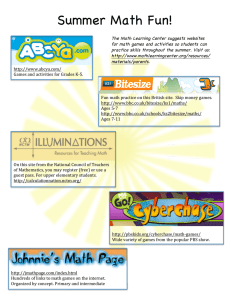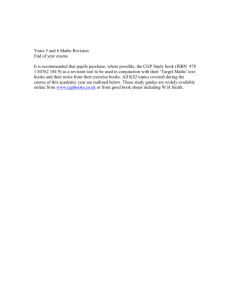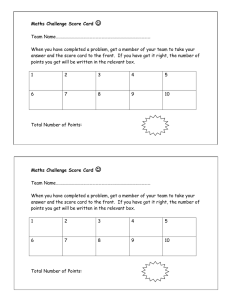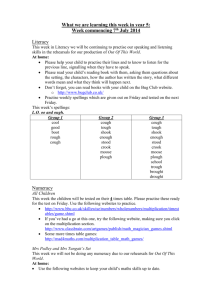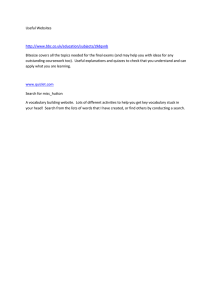Why not visit www.bbc.co.uk/schools/ks2bitesize/maths/ www.bbc.co
advertisement
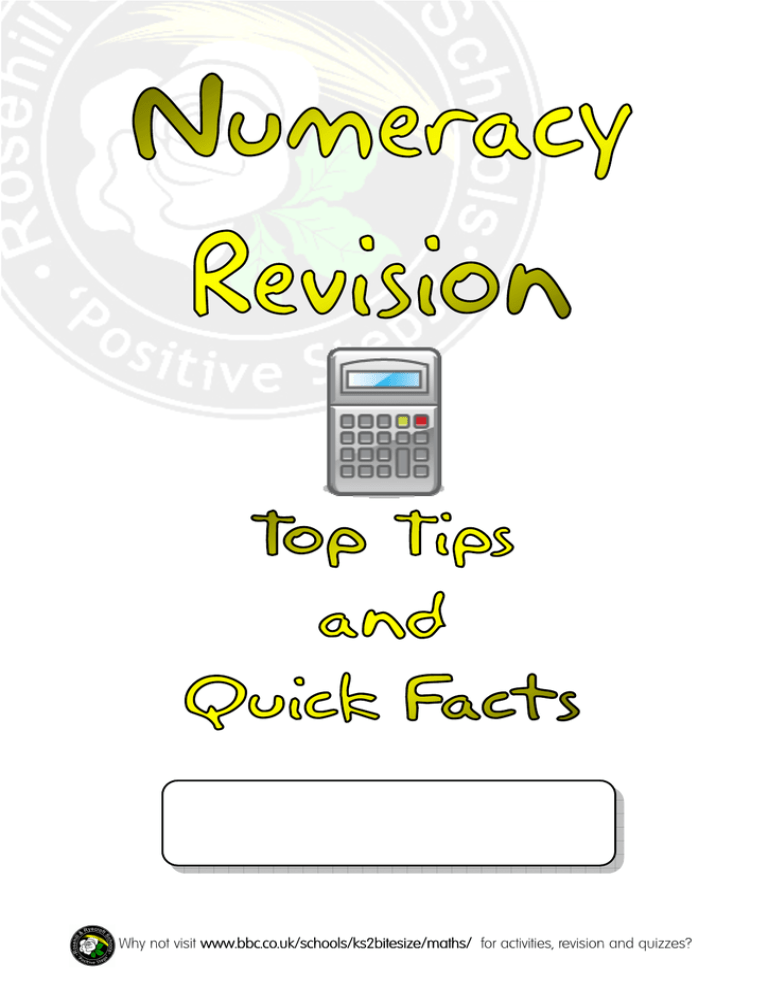
Why not visit www.bbc.co.uk/schools/ks2bitesize/maths/ for activities, revision and quizzes? Why not visit www.bbc.co.uk/schools/ks2bitesize/maths/ for activities, revision and quizzes? Looking at this booklet will fill some of your time Learning these facts will help you remember them Using these facts will help you know and apply them Vitally important! • KNOW your times tables for QUICK recall. KNOW the inverse of each. • Remember that multiplication and division are opposites— know how to swap them around! • Remember that addition and subtraction are opposites— know how to swap them around! • < ‘is less than’ > ‘is more than’ = ‘is equal to’ Why not ask someone to help you learn these facts at home and then think of some examples where you could use them. Some examples are near the end of the booklet. Why not visit www.bbc.co.uk/schools/ks2bitesize/maths/ for activities, revision and quizzes? Measurement ‘kIilo’ =1000 ‘milli’ = one thousandth ‘centi’ = one hundredth 10mm = 1cm so… 1.2cm = 12mm, 14.7cm = 147mm 100cm = 1m so… 104cm = 1.04m, 1kg = 1000g so… 1003g = 1.003kg, 1030g = 1.030kg 1km = 1000m so… 1007m = 1.007km, 1070m = 1.070km, 1l (litre) =1000ml so… 3008ml = 3.008l How many cm in 4.5m? 143cm = 1.43m 308ml=0.308l How many metres in 0.5km? Money 2 x 50p =£1.00, 10 x 10p = £1.00, 204p = £2.04, 4 x 25p = £1.00, 5 x 20p = £1 £2.47 = 247p, 4 x £2.50 = £10.00, 4 x £250 = £1000 Why not visit www.bbc.co.uk/schools/ks2bitesize/maths/ for activities, revision and quizzes? Angles • Degrees in a right angle = 90º 90º • Degrees in a straight line or 2 right angles = 180º 180º, • 3 right angle turns (three quarters of a circle)= 270º 270º • Degrees in a circle, circle or 4 right angles = 360º 60º • Degrees in a triangle = 180º 180º • Angles in an equilateral triangle are 60º+60º+60º=180 180º 180º • Degrees in a quadrilateral = 360º 360º Area/Perimeter/Volume • Area is written in square units e.g. cm2 • Area of a rectangle = length x width. • Area of a triangle = ½ base x height. • Perimeter = all the sides added together. • Volume of a cuboid = length x width x height. Equivalent Imperial – metric units. (approximate (approximate) imate) 1 pint = ½ l, 1l = 2 pints 2 pounds (lbs) = 1 kg 1 mile = 2 km 1 inch = 2 ½ cm Why not visit www.bbc.co.uk/schools/ks2bitesize/maths/ for activities, revision and quizzes? Negative numbers 0……+10……+20……+30 -30……-20……-10…… -10….-8….-6….-4….-2…. 0….+2….+4….+6….+8….+10 Time 60 seconds = 1 minute, minute 24 hours = 1 day, day 365 days = 1 year, year 60 minutes = 1 hour, hour 7 days = 1 week, week 10 years = 1 decade, decade 52 weeks = 1 year, year 100 years= 1 century Number of days in the months: 30 days hath September, April, June and November, All the rest have 31, Excepting February alone. Which only has but 28 days clear And 29 in each leap year 24 hour clock 1am = 1:00, 1pm = 13:00, 2pm = 14:00, 7pm = 19:00, 10pm = 22:00 5pm = 17:00, Why not visit www.bbc.co.uk/schools/ks2bitesize/maths/ for activities, revision and quizzes? Useful Facts • CoCo-ordinates: ordinates “Along the corridor and up the stairs” (3,2) = 3 along and 2 up • Brackets (…….) means do this first e.g. 4 + (7x5) = 4 + 35 = 39 (4 + 7) x 5 = 11 x 5 = 55 • In column subtraction, subtraction 2 – 9 cannot be done without swapping from the next column: 8 23 12 - 3 7 9 8 3 2 - 3 7 9 7 8 123 12 - 3 7 9 4 5 3 line!!!! If in doubt use a number line • In division remember to add .00 to help work out decimal answers instead of remainders: 0 5 2 23 4 5 2 3 4 0 4 6 5 2 23 34 • • 40 0 0 4 6 5 2 23 34 0 4 5 2 23 34 • • 8 0 4 0 0 Why not visit www.bbc.co.uk/schools/ks2bitesize/maths/ for activities, revision and quizzes? Fractions To find a fraction of a number: “Divide by the bottom, then multiply by the top” To find 2/3 of a number, divide by 3 then x by 2. For equivalent fractions, REMEMBER – e.g: 1 4 2 /2 = /8 /10 = 1/5 2 /3 = 4/6 6 1 /3=2/6 /10 = 3/5 Percentages % means out of 100 1% = 1/100 = 0.01 10% = 1/10 = 0.1 25%= 1/4 , = 0.25 75% = 3/4 , = 0.75 You can find 21% of a number by finding 10% and 1% and adding these to make 21% e.g: 21% of 450 10% (divide 450 by 10) = 45 1% (divide 450 by 100) = 450 21% = 10% + 10% + 1% so 21% = 45 + 45 + 4.5 = 94.5 To find 45% of 250 on a calculator, key in 2 5 0 x 4 5 then % (no equals) Why not visit www.bbc.co.uk/schools/ks2bitesize/maths/ for activities, revision and quizzes? Times Tables X 1 2 3 4 5 6 7 8 9 10 1 2 3 4 5 6 7 8 9 10 1 2 3 4 5 6 7 8 9 2 4 6 8 10 12 14 16 18 20 3 6 9 12 15 18 21 24 27 30 4 8 12 16 20 24 28 32 36 40 5 10 15 20 25 30 35 40 45 50 6 12 18 24 30 36 42 48 54 60 7 14 21 28 35 42 49 56 63 70 8 16 24 32 40 48 56 64 72 80 9 18 27 36 45 54 63 72 81 90 10 20 30 40 50 60 70 80 10 90 100 This multiplication grid will help you learn your tables. You need to know all of these and the division facts linked to them e.g: 7 x 8 = 56 so 8 x 7 = 56 and 56 ÷ 7 = 8 and 56 ÷ 8 = 7 Square numbers are shown on here with dashes around them – a squared number is the result of multiplying a number by itself. Multiples are any number that can be found by multiplying a given whole number e.g: Multiples of 8 include 24, 16, 72 and 88 because these are in the 8 times table Factors Factors are whole numbers by which a number can be divided by e.g: Factors of 30 include 2, 10, 3 and 5 because 30 can be divided by these numbers to get a whole number answer Prime Numbers can only be divided by themselves and 1, they have no other factors Why not visit www.bbc.co.uk/schools/ks2bitesize/maths/ for activities, revision and quizzes? Averages There are 3 types of averages when looking at a set of data Definitions: MODE: is the one that occurs the most often. often MEDIAN: is the middle number. TOP TIP: TIP rearrange the numbers & list them in order, to help work this out averages. MEAN: add up the data to find the total and then divide by the number of items. The range: range the how much the information is spread between the smallest and largest value. Mode is 5 eggs because there are more of this number than any other. Number of eggs laid Day 9 5 5 Monday Tuesday Wednesday Thursday Median is 5 eggs because: 8 3 Friday If there is an even number of values, take the two middle numbers, add them together and divide by 2. Put them in order from largest to smallest 3, 5, 5, 8, and 9. There are 5 numbers. The middle number is the third value, which is 5. Mean is 6 eggs because: Find the total number of eggs: 9 + 5 + 5 + 8 + 3 = 30 The total is divided by the number of item: 30 divided by 5 The range is from 3 to 9 eggs Why not visit www.bbc.co.uk/schools/ks2bitesize/maths/ for activities, revision and quizzes? Polygons Definitions:: a polygon is any flat shape with straight sides Definitions Regular shapes have all sides and all angles equal. Triangles Triangles: iangles: equilateral isosceles 3 equal sides 3 equal angles of 60o right angled scalene 2 equal sides 2 equal angles 1 angle is a right angle of 90o oblong kite no equal sides no equal angles Quadrilaterals: Quadrilaterals: square 4 equal sides 4 right angles 4 lines of symmetry opposite sides are equal and parallel 2 pairs of equal sides 4 right angles 2 lines of symmetry opposite sides are equal and parallel rhombus 2 pairs of adjacent sides are equal 1 line of symmetry 1 pair of opposite angles are equal parallelogram 4 equal sides opposite angles are equal and are parallel 2 lines of symmetry circle 2 pairs of parallel sides opposite sides are equal and are parallel pentagon hexagon delta trapezium 1 pair of parallel sides heptagon octagon radius diameter Why not visit www.bbc.co.uk/schools/ks2bitesize/maths/ for activities, revision and quizzes? USING THESE FACTS Look through the kitchen cupboards: • Can you convert the weight of tins and packets from g to kg? • How about the volume of a can of pop from ml to l? • How many tins of x would be needed to make 1kg? How many right angles can you find in one room of the house? Measure the length and width of a book or box. Can you find its perimeter and area? When shopping calculate the cost of 3 items and how much change you would have or how much more money you would need need from £5, £2.55 or £10. £10. How much would things cost with 10% or 25% off? Watch the weather on TV. What would the temperature be if it were to fall by 10oC, 15 oC or 20 oC Look at the TV schedule: schedule: • Which program will be on the longest? • How much longer is that than the shortest program? • Can you convert the times from 24 hour clock to am and pm times? Practice different methods of the 4 operations (+ - x ÷)). Make sure you can deal with up to 4 digits, including some with decimals Look at the weather forecasts forecasts in a newspaper; calculate the mode, median and mean over a few days. KNOW your times tables AND the division facts linked to them – be able to give your answers QUICKLY Why not visit www.bbc.co.uk/schools/ks2bitesize/maths/ for activities, revision and quizzes?
